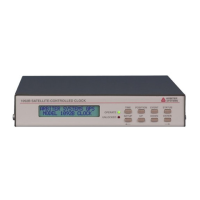24 Setting Internal Jumpers
For RS-232C Event Trigger Operation, it is necessary to configure the clock as described in
Section 9.2.8, “RS-232C Event Trapping.”
5.3.5 Output Signal Select, JMP1 and JMP2
JMP1 and JMP2 (available only if the 200 V open-drain outputs have been installed) select between
the standard surge-protected 5 V CMOS drivers (position A) and the 200 V open-drain FET drivers
(position B). JMP1 controls the signal at pin 1 (IRIG-B unmodulated, or Programmable Pulse) and
JMP2 controls the signal at pin 5 (1 PPS, or Programmable Pulse). The drive of the open-drain
FETs has been inverted, so that the signal at this pin (with an external pull-up) will have the
same polarity in either mode of operation. Also note that the open-drain outputs do not have any
protection against reverse polarity, transient over-voltage, or over-current. It is the responsibility
of the user of this function to provide the necessary protection. Maximum recommended operating
voltage is 150 VDC (200 V peak) and continuous operating current is 100 mA (power limited).
5.3.6 Data Backup Battery, JMP5 (Option 02) - Obsolete
Jumper JMP5 is no longer used. All new GPS receivers incorporate an manganese-lithium recharge-
able data backup battery.
5.3.7 RS-232 AUX Out, JMP6
The function of the AUX OUT line, pin 4 of J6, may be changed from a handshake line (position
“A”) to Programmable Pulse, at RS-232 levels (position “B”). This may be used to provide a
synchronization pulse, which can generate an interrupt in a host computer.

